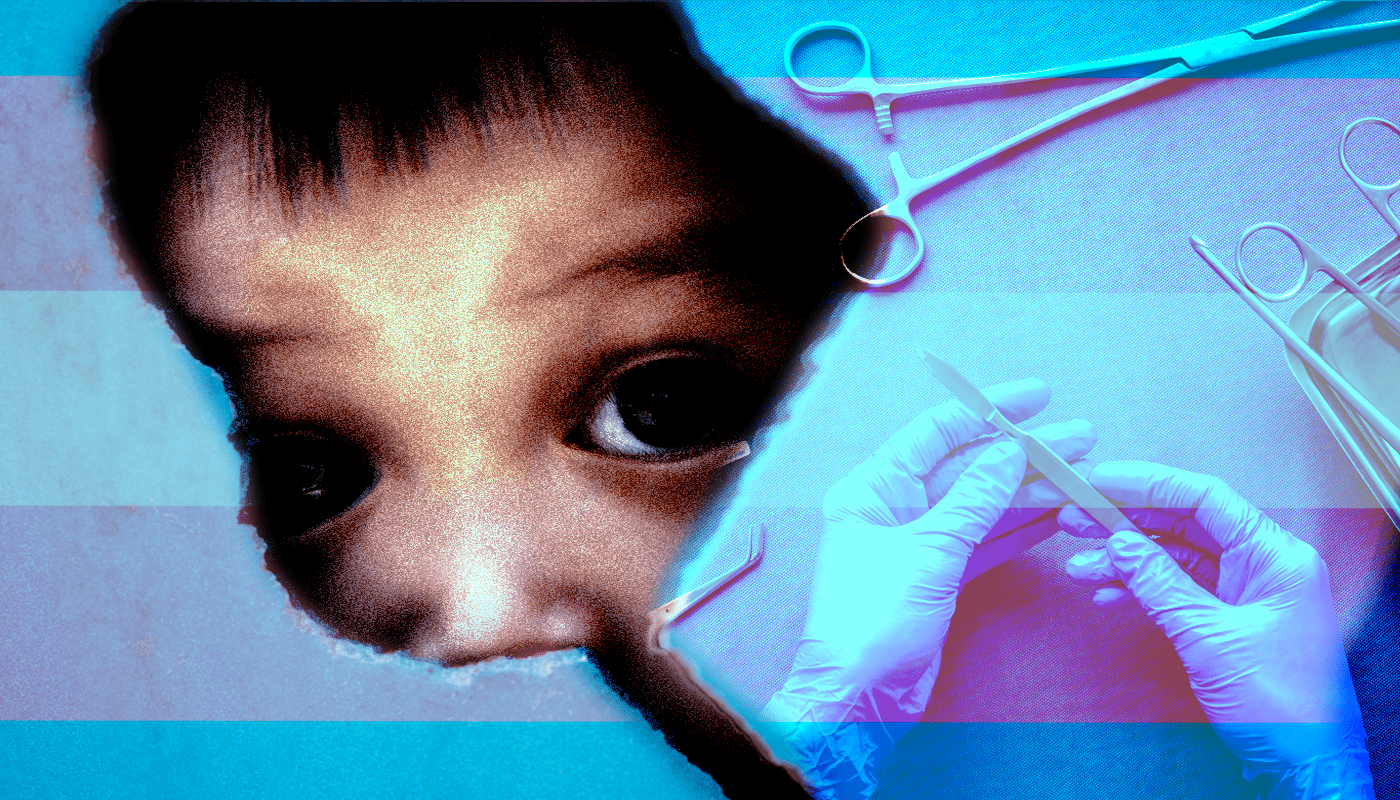A movement has steadily grown in the western world aggressively promoting the surgical mutilation and hormonal manipulation of one’s body as “gender affirming.” Scientifically reliable papers and physicians caution about the dangers of these risky procedures.
Over time, this biologically subversive movement has expanded to target children, including Texans. But while children here remain at risk, elsewhere in the West the tide is shifting.
The Post Millennial recently reported that, after the British National Health Service published an October 20 review, the United Kingdom is considering eliminating their “affirmation-only” approach, which would include stopping the usage of puberty blockers.
Indeed, as Dr. Andre Van Mol, co-chair of the American College of Pediatrician’s Committee on Adolescent Sexuality and the Sexual and Gender Identity Task Force of the Christian Medical & Dental Association, points out this is not an isolated incident. He informed Texas Scorecard that the British, Swedish, Finnish, and French governments, medical, and academic institutions have shifted from promoting so-called “gender-affirming transitions” for minors to mental health evaluation and support.
In this piece, we will examine what scientifically reliable documentation and testimony say about the risks these procedures pose to adults and children.
Background
Since the 20th century, gender has been warped from being a generally accepted scientific fact to a political warzone. It is now regularly argued by political forces that one’s gender is an abstract idea that one can manipulate how he or she wishes.
But there are those who reportedly believe that their gender differs from that assigned at birth. This is known as gender dysphoria, which the Mayo Clinic defines as “the feeling of discomfort or distress that might occur in people whose gender identity differs” from what they were born as. This condition is usually the trigger that leads to the misleading hope of the abusive medical procedures of gender mutilation and hormone manipulation.
In 2019, the Royal College of General Practitioners reported that gender identity clinics in England had “seen a 240% overall increase in referrals over five years.”
“Gender dysphoria has increased in prevalence both in Finland and in other Western countries,” wrote the Council for Choices in Health Care in Finland (CCHCF), June 2020. “Some people suffering from gender dysphoria seek diagnostic examinations, a portion of them are diagnosed as gender non-binary, and still fewer wish to undergo treatments that would permanently modify their bodies.”
While “fewer wish to” undergo such treatments, the amount of those who do in America has increased. A February 2018 study by Johns Hopkins University examined this issue, analyzing data from the National Inpatient Sample,”the largest inpatient care database in the U.S.” The study found that from 2000 to 2014, usage of these unproven procedures had increased “four-fold.”
From 2006 to 2011, approximately 65 percent of these were paid out of pocket. This changed dramatically from 2012 to 2014, when 39 percent were paid out of pocket and the remainder were paid for by taxpayers or “private insurance.”
The study reported that Obamacare “banned discrimination on the basis of gender identity,” and that triggered a shift by federal and state regulators toward coverage of these unproven procedures.
While usage of these procedures have increased, so too has customer dissatisfaction.
“What we do have are hundreds, if not thousands, of people in their mid-20s who are broken, who are depressed, who are suicidal,” said Chris Hopper, executive director of Texas Family Project.
Buyer’s Remorse
Around the time a John Hopkins’ study found sex-change procedures were increasing, regret for the same procedures was growing.
A 2021 white paper from Lisa Littman, located on the Transgender Trend website, reports that since 2014 there has been a steady rise of men and women who experience buyer’s remorse after opting for these procedures. From news articles to YouTube videos and the “detrans” subreddit—which started with 100 members and today stands at more than 39,000—a growing mass of people have been shouting that they wish they hadn’t bought the misleading hope advertised to them as the solution for their emotional struggles.
“The prevailing cultural narratives about detransition are that most individuals who detransition will retransition and that the reasons for detransition are discrimination, pressures from others, and nonbinary identification,” Littman wrote. “However, case reports are shedding light on a broader and more complex range of experiences that include trauma, worsened mental health with transition, re-identification with natal sex, and difficulty separating sexual orientation from gender identity.”
Littman goes further sharing what was learned from detransitioners themselves. The report shows that “trauma (including sexual trauma) and mental health conditions contributed to” individuals identifying as transgender and opting for transition. It also showed that individual gender dysphoria and transition were fueled by an internal conflict over their sexual desire for a member of the same sex. Littman’s paper also listed the influence of social media as a major factor.
This is substantiated by the Cass Review interim report, supervised by Dr. Hilary Cass, to the British National Health Service. Published in February 2022, it notes there are “therapists who work with detransitioners and people with regret” and that these therapists say there is a “need for services to support this population.”
In other words, the misleading “hope” gender mutilation and hormone manipulation offers has hurt, not helped.
“From state-level bills in my home state of California to national policy initiatives from the federal administration, the assertion that transitioning for gender dysphoria is all but regret free is used as a promotional tool for the proposed mandating of [Gender Affirming Therapy] essentially on request,” wrote Dr. Andre Van Mol. “The studies claiming regret to be extremely uncommon are usually fatally flawed by high rates of loss to follow up, excessively rigid definitions of regret, insufficient length of follow up, sampling bias and low-quality data, which can then get pooled into larger amounts of low-quality data.”
Furthermore, in August 2020, Dr. Van Mol wrote about how the American Journal of Psychiatry was forced to issue a “rare and important correction” that month to an earlier study they published by Richard Branstrom and John Pachankis, Ph.Ds. The study is titled “Reduction in mental health treatment utilization among transgender individuals after gender-affirming surgeries: a total population study.” After Dr. Van Mol and others challenged the study with other data, AJP sought “statistical consultations” that led to the correction where “the study authors were asked to reanalyze their data and the results demonstrated ‘no advantage to surgery’ for their three endpoints in the subject population.”
“Branstrom and Pachankis sought to generate ‘support for policies that ensure coverage of gender-affirming treatments.’ Their study demonstrated that neither ‘gender-affirming hormone treatment’ nor ‘gender-affirming surgery’ achieved reductions in utilization of mental health services for transgender-identified people in the first of its kind total population study of them,” Dr. Van Mol wrote. “Our team is of the conviction that many of the pro-transition studies we have read fare no better. Fad medicine is bad medicine, and gender anxious people deserve better than the rush to transition.”
Aside from this buyer’s remorse and data that defy mainstream narratives, questions also remain about the safety of these unproven procedures.
Safe and Effective?
“Nobody wants to be 30 years old and worrying about if they’re leaking pee or feces,” Dr. Gloria Gamboa, who practices family medicine in Farmersville, Texas, told Texas Scorecard.
Dr. Gamboa shared her comments based on her research of the results of sex-change surgeries and feedback from the patients themselves. “From reading about the results that patients have written about these surgeries … they are still not adequate. They are still deforming, and they are leaving patients with significant side effects and disabling patients.”
She broke down the consequences for men. “I have read that for the guys, the [sic] incontinence is a big problem and that the pouch that they’re given does not function well. Ingrown hairs from the skin being improperly transferred is a big issue; they’re having hair inside that vaginal pouch, and when one ingrows, it’s very painful,” she explained. “They have to use dilators to even make that pouch functional, or—if at all—it’s very painful to use that. And then they’re left with a penile stump. That is painful, and the ability to have any sort of meaningful sexual intercourse is not there, especially with problems with the surgery.”
Dr. Gamboa also described the consequences for women. “If they do close up the vaginal area, that cannot be reopened,” she said. “One of the most common surgeries—and in fact, I think it’s the most common surgery—is removing the breast. Those cannot be put back. The women are left unable to breastfeed their infant.” (That’s assuming they don’t opt to have their ovaries removed.)
Dr. Andre Van Mol also mentioned that certain procedures can cause loss of ability to achieve orgasm. “There are a lot of people that are not aware it’s a reality,” he told Texas Scorecard. “A phalloplasty in a biologic woman or a vaginoplasty in a biologic man … these things are cosmetic, they are pseudo genitalia, they’re usually not particularly functional. You would expect, generally speaking, these people would have no orgasms, and sterility is guaranteed.”
Dr. Gamboa and Dr. Van Mol are not alone in her concerns about these abusive medical procedures.
A June 2020 scientific report by the Council for Choices in Health Care in Finland (CCHCF) states:
Surgical procedures permanently modify the body and pose a risk of scarring, loss of sensation and functional harm.
Surgical procedures should be carried out only once it has been confirmed that the psychological state of the person is such that they understand the aftercare required for surgical procedures and the risk of permanent harm associated with the treatment.
But what of the so-called hormone “therapy?”
“I think ‘hormone manipulation’ is probably a better term,” Dr. Gamboa said. Here too, the CCHCF report advises caution. “When implementing hormone therapy, consideration should be given to the principles of good clinical practice, individual objectives and any adverse effects that may also lead to discontinuation of treatment.”
What kinds of “adverse effects”? The Cass Review interim report sheds some light. “Sex hormones have been prescribed for transgender adults for several decades, and the long-term risks and side effects are well understood,” it states. “These include increased cardiovascular risk, osteoporosis, and hormone-dependent cancers.” Even so, the report also states “there is still a lot we don’t know about the long-term effects.”
“Anytime you take any sort of hormones for whatever reason, you do risk having a venous clot, a deep venous clot … usually in the legs, but it can occur [in] other places like the lungs,” Dr. Gamboa continued. She said both sexes also risk infertility and coarsening of the facial features, and women who receive testosterone can experience voice changes, a “growth of cartilage,” changes in the neck, and facial hair growth.
The CCHCF report warns that “changes caused by hormone therapy are at least partially reversible if treatment is discontinued.”
Targeting Children
Despite scientific evidence opposing these procedures, the western world has seen the target range of this misleading hope expand to include children.
In the United Kingdom, referrals to their Gender Identity Development Service (GIDS) shot up over the decade, from 250 to 5,000 in 2021. “In recent years, there has been a significant increase in the number of referrals to the Gender Identity Development Service (GIDS) at the Tavistock and Portman NHS Foundation Trust,” the Cass Review stated.
Such increases were seen elsewhere. Commissioned by the Swedish government, a December 2019 report from Sweden SBU, which conducted “a scoping review of the literature on gender dysphoria in children and adolescents,” also revealed a rise of referrals for these and similar procedures for children. “We have not found any scientific studies which explains the increase in incidence in children and adolescents who seek the health care because of gender dysphoria.”
This is an issue that has reached Texas as well, as seen with the case of James Younger—a young boy whose mother—Anne Georgulas—has told him he’s actually a girl. Georgulas wants James to undergo the abusive medical procedures of gender mutilation and hormone manipulation. His dad, Jeff Younger, opposes this and has been fighting his ex-wife in court to stop her efforts.
A Dallas judge recently ruled that James’ mom can move him anywhere in the continental U.S. without Jeff’s permission.
But is bias towards the misleading hope of gender mutilation and hormone manipulation leading medical practitioners to favor radical procedures while ignoring life-changing factors?
The Cass Review found that in the U.K., minors referred for these procedures had deeper needs going unaddressed. “In addition, the majority of children and young people presenting to GIDS have other complex mental health issues and/or neurodiversity. There is also an over-representation of looked after children.” (A looked after child is defined as “a child who has been in the care of their local authority for more than 24 hours.”)
Dr. Andre Van Mol says the scientific data shows an average of 85 percent of minors diagnosed with gender dysphoria resolve their issues on their own by adulthood “unless it is affirmed.”
“Why permanently medicalize a child for a condition that usually goes away?” he wrote.
Yet, it appears these concerns were swept under the rug and ignored as children in the U.K. were hyperdrived for these abusive medical procedures—something the Cass Review called “diagnostic overshadowing.”
“Many of the children and young people presenting have complex needs, but once they are identified as having gender-related distress, other important healthcare issues that would normally be managed by local services can sometimes be overlooked.”
Medical literature strongly advised against such overshadowing. “Premature labeling of gender identity should be avoided,” states the “APA Handbook on Sexuality and Psychology (W. Bockting, Ch. 24: Transgender Identity Development” in 1 American Psychological Association Handbook on Sexuality and Psychology, 750 (D. Tolman & L. Diamond eds., 2014). “This approach runs the risk of neglecting individual problems the child might be experiencing.”
“An adolescent’s gender identity concerns must not become a reason for failure to address all her/his other relevant problems in the usual way,” writes the Nordic Journal of Psychiatry.
“Trans-identification and its associated medical treatment can constitute an attempt to evade experiences of psychological distress,” wrote Robert Withers in The Journal of Analytical Psychology.
There is also the question of whether children can even give informed consent to such procedures. Scientific and legal voices say no. “The young brain is biologically and socially immature, tends towards short-term risk taking, does not possess the ability to comprehend long term consequences and is highly influenced by peers,” wrote Anthony Latham, chair of the Scottish Council on Human Bioethics, in his 2022 paper titled “Puberty Blockers for Children: Can They Consent?”
“Children cannot consent, and therefore should not be asked to consent to being treated with puberty blockers for gender dysphoria.”
A British High Court agreed. “There is no age appropriate way to explain to many of these children what losing their fertility or full sexual function may mean to them in later years,” they ruled in Bell v. Tavistock in 2020. The Swedish Pediatric Society came to the same conclusion in 2019. “Giving children the right to independently make vital decisions whereby at that age they cannot be expected to understand the consequences of their decisions is not scientifically founded and contrary to medical practice.”
Such has been the aggressive targeting of minors with these procedures that the concerns listed above have been ignored, while government power in America is in the process of being weaponized against concerned parents. Grassroots citizens have appealed for California Gov. Gavin Newsom (D) to veto a bill passed by the state legislature that would rob parents of custody over their children should they stand in the way of their child receiving the irreversible damage from “gender-affirming care.”
Known Unknowns
As was said before, the risks children are being exposed to are not often discussed. But there are also known unknown risks to consider.
Regarding physical alterations, the Cass Review notes there is the “irreversible nature of many of the changes.”
“Decisions need to be informed by long-term data on the range of outcomes, from satisfaction with transition, through a range of positive and negative mental health outcomes, through to regret and/or a decision to detransition.” Cass reports that there is “poor quality of these data, both nationally and internationally.”
The shocking lack of data being collected on what happens to minors who proceed with these medically questionable procedures was mentioned again. “Internationally as well as nationally, longer-term follow-up data on children and young people who have been seen by gender identity services is limited, including for those who have received physical interventions; who were transferred to adult services and/or accessed private services; or who desisted, experienced regret or detransitioned,” the Cass Review reports. “There has been research on the short-term mental health outcomes and physical side effects of puberty blockers for this cohort, but very limited research on the sexual, cognitive or broader developmental outcomes.”
There are also known unknown risks associated with hormone manipulation.
In 2019, the British Royal College of General Practitioners published a statement offering scientifically warranted caution about subverting the biological development of children’s hormones. “Gonadorelin (GnRH) analogues are one of the main types of treatment for young people with gender dysphoria. These have long been used to treat young children who start puberty too early, however less is known about their long-term safety in transgender adolescents. Children who have been on GnRH for a certain period of time and are roughly 16 years of age can be offered cross-sex hormones by the NHS, the effects of which can be irreversible,” the statement reads. “There is a significant lack of robust, comprehensive evidence around the outcomes, side effects and unintended consequences of such treatments for people with gender dysphoria, particularly children and young people, which prevents [general practitioners] from helping patients and their families in making an informed decision.”
The Cass Review stressed that “there is very limited follow-up” on the children and young people who get hormone manipulation. This “lack of follow up data” it states “limits our understanding about the long-term outcomes of these” procedures, and this “should be corrected.” The Review continues that “additional physical risk” of such manipulation, starting at 16 and up rather than 18 and up, “is unlikely” to add “significantly” to the total lifetime risk, but they caution that “data on this will not be available for many years.”
For young people, the Review states the “impact on fertility, with the need for fertility counseling and preservation” should be considered.
The lack of data was mentioned elsewhere, too. “Research data on the treatment of dysphoria due to gender identity conflicts in minors is limited,” wrote the Council for Choices in Health Care in Finland in 2020 (CCHCF). “There is also a need for more information on the disadvantages of procedures and on people who regret them.”
The 2019 Sweden SBU report agreed. “There are few studies on gender affirming surgery in general in children and adolescents and only single studies on gender affirming genital surgery,” it stated. “Studies on long-term effects of gender affirming treatment in children and adolescents are few, especially for the groups that have appeared during the recent decennium.”
But doesn’t such “gender-affirming” care reduce suicides among gender dysphoric adolescents? “There is no persuasive evidence that gender transition reduces gender dysphoric children’s likelihood of killing themselves,” write J. Michael Bailey and Ray Blanchard in their 2017 paper titled “Suicide or transition: The only options for gender dysphoric kids?”
Defying Science
Despite reliable scientific papers alerting to the dangers of these abusive medical procedures for children and adults, there’s been a push to stop being scientific. The conflict of late has been between those in the medical community wanting open and rigorous debate and those dedicated to the establishment narrative.
“Primary and secondary care staff have told us that they feel under pressure to adopt an unquestioning affirmative approach and that this is at odds with the standard process of clinical assessment and diagnosis that they have been trained to undertake in all other clinical encounters,” Dr. Cass states in the interim report.
“At primary, secondary and specialist level, there is a lack of agreement, and in many instances a lack of open discussion, about the extent to which gender incongruence in childhood and adolescence can be an inherent and immutable phenomenon for which transition is the best option for the individual, or a more fluid and temporal response to a range of developmental, social, and psychological factors.”
Similar activity was seen during the Chinese coronavirus, with government and the medical establishment colluding to silence all voices that questioned masking, social distancing, and vaccination as effective responses to the virus.
All About the Benjamins
One question that should be asked is how lucrative these medically questionable procedures are.
A transgender clinic in India states that “on average, the [female-to-male] surgery cost starts from Rs 4,00,000 and can go higher depending on which procedure you want to get.” Translated to American dollars, that’s more than $4,900. For the so-called male-to-female surgery, costs “may range” from more than $2,400 USD to more than $6,100.
But what about within the United States?
On May 17, 2022, investigative reporter Christopher Rufo shared a video of Dr. Scott Mosser, who runs a private practice in San Francisco, admitting he had done “over 2,000” procedures to remove girls breasts, otherwise known as “top surgeries.” Rufo found that Dr. Mosser advertises such surgeries “on his website for $8,500 to $10,000.”
“Assuming these numbers, he has earned up to $20 million performing double mastectomies on young girls.”
Dr. Andre Van Mol also discussed greed as a driving force of these abusive medical procedures. “Once you’ve medicalized somebody, they’re medicalized for the rest of their life. They will never stop needing those cross sex hormones. They will never quit needing treatment for those possible complications that come with it,” he told Texas Scorecard. “If they engaged in surgery, that has a complication rate. And if they engage in further surgery, more so yet. Therefore any biotech firm that can come up with some widget that makes a biologic male look more like a female, or vice versa, it’s all money in the bank and it goes on as long as that person is alive.”
Texas Scorecard asked Dr. Van Mol if surgical mutilation and hormone manipulation are medical malpractice. “We sure think it is. The problem is the people doing this,” he replied. There’s the ideological group who really, really believe this is what you do. And there’s the profiteering group—which is the worst possible face of capitalism—trying to increase their market share: the pharmaceutical firms, the biotech firms, the surgeons, the gender clinics, etc.”
Conclusion
Legitimate concerns exist about the risks and side effects of surgical mutilation and hormone manipulation. Fortunately, it appears the West is coming into line with science.
Dr. Van Mol wrote in 2020 that Britain’s High Court found “that puberty blockers (PB) and cross-sex hormone (CSH) use in gender dysphoric minors was experimental and should not, in most cases, be given to children under 16 without court order, adding that such petitioning was also advisable for 16 to 17 year olds.” The court stated, “There is no age appropriate way to explain to many of these children what losing their fertility or full sexual function may mean to them in later years.”
After the Cass Review interim report was published, the BBC reported in July that the British National Health Service decided to close its Gender Identity Development Service next year and replace it with centers in London and northwest England that “will aim to help support young people under the age of 18 who are struggling with their gender identity, and be linked to mental health care and GP services where relevant.”
There is some evidence that this attitude has reached American shores. On April 20, 2022, the Florida Dept. of Health published guidelines on the “Treatment of Gender Dysphoria for Children and Adolescents.”
The guidelines state:
Social gender transition should not be a treatment option for children or adolescents. Anyone under 18 should not be prescribed puberty blockers or hormone therapy. Gender reassignment surgery should not be a treatment option for children or adolescents.
Based on the currently available evidence, “encouraging mastectomy, ovariectomy, uterine extirpation, penile disablement, tracheal shave, the prescription of hormones which are out of line with the genetic make-up of the child, or puberty blockers, are all clinical practices which run an unacceptably high risk of doing harm.”
Oklahoma is following suit as well. In October, The Epoch Times reported that Gov. Kevin Stitt (R) signed into law legislation blocking federal taxpayer COVID funding from flowing to the Oklahoma University Children’s Hospital unless it stops “gender-affirming” treatment on children.
Meanwhile, Texas remains a battleground with the safety of children at stake.
In Part 2 of this series, we will examine the deep state war within the Texas government to block efforts to protect children from these procedures.
No ads. No paywalls. No government grants. No corporate masters.
Just real news for real Texans.
Support Texas Scorecard to keep it that way!





